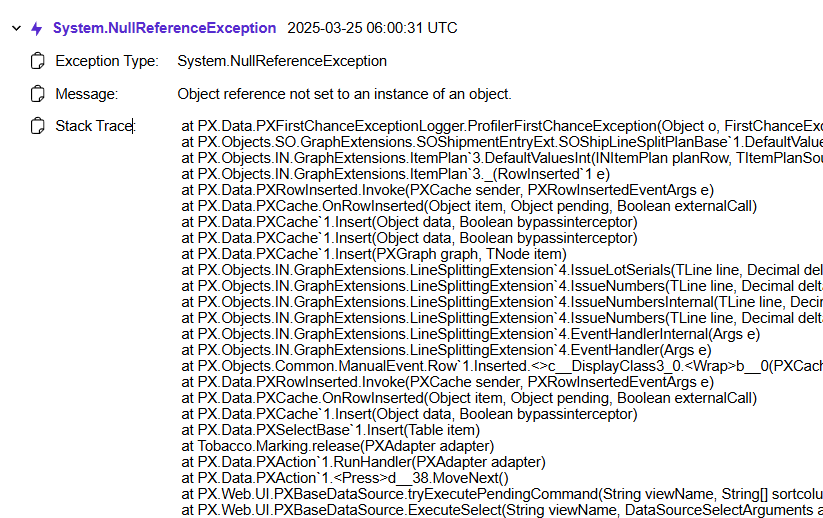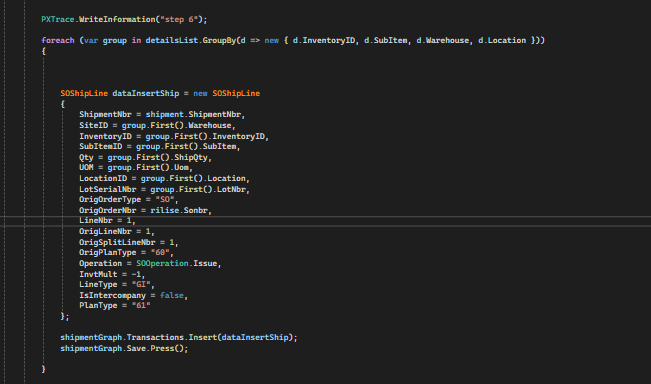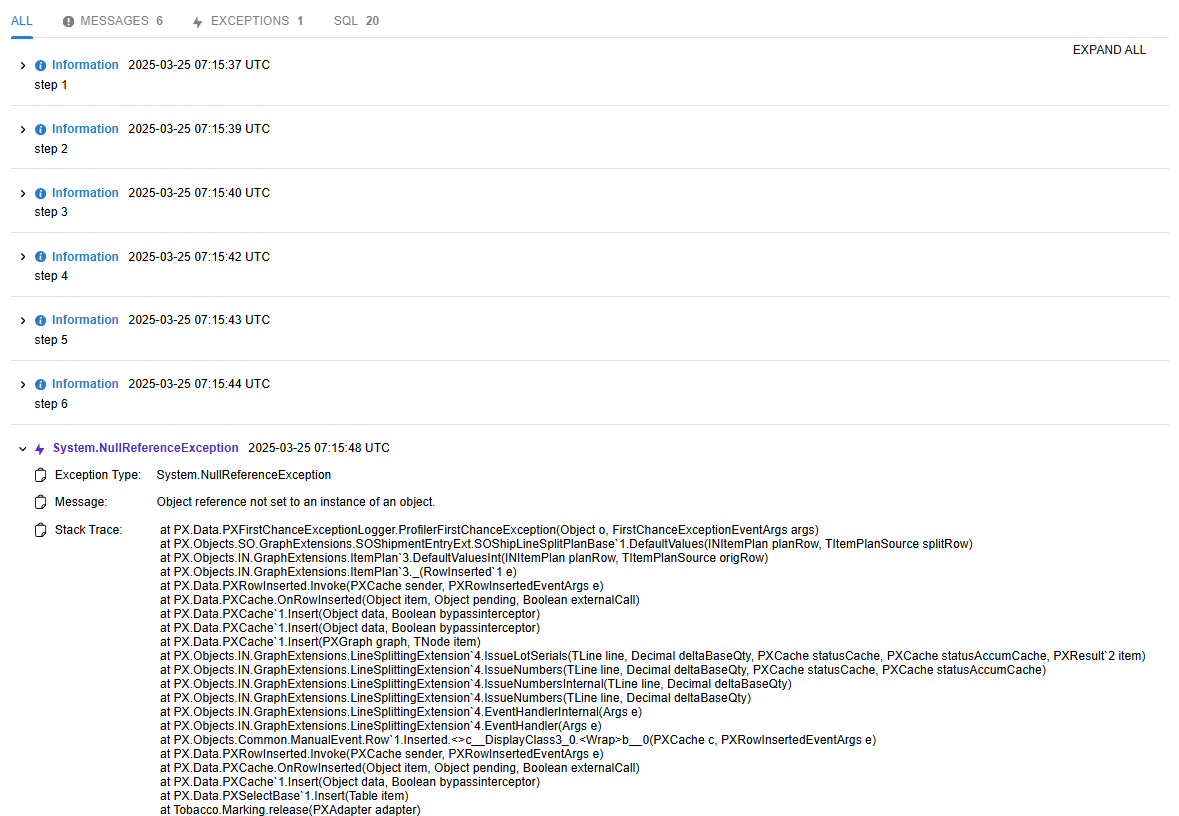I am Get erorr "Object reference not set to an instance of an object" when trying insert shipment,
Why Like This ?
This the problem track
Please Help me Sense

Thanks you
I am Get erorr "Object reference not set to an instance of an object" when trying insert shipment,
Why Like This ?
This the problem track
Please Help me Sense

Thanks you
Hi
This error usually happens when the code tries to use an object that hasn't been initialized or it is null.
Can you share your customization or the code you're using? That will help in finding the exact issue.
Thanks
This is error code

and than the track like this

this is full code for metod rilise button
public PXAction<ITMarking> Release;
[PXUIField(DisplayName = "RELEASE", MapEnableRights = PXCacheRights.Select, MapViewRights = PXCacheRights.Select, Visible = false)]
[PXButton(SpecialType = PXSpecialButtonType.Process, Connotation = PX.Data.WorkflowAPI.ActionConnotation.Success)]
public virtual IEnumerable release(PXAdapter adapter)
{
PXTrace.WriteInformation("step 1");
ITMarking rilise = MasterView.Current;
if (rilise?.MarkingNbr != null && rilise.MarkingNbr != "" && rilise.MarkingNbr != "[DocumentID]" && rilise.MarkingNbr != "<NEW>")
{
SOShipmentEntry shipmentGraph = PXGraph.CreateInstance<SOShipmentEntry>();
ShipementDua shipementLine = PXGraph.CreateInstance<ShipementDua>();
var customerID = SelectFrom<SOOrder>
.Where<SOOrder.orderNbr.IsEqual<P.AsString>>
.View.Select(this, rilise.Sonbr)
.TopFirst?.CustomerID;
var customerLocationID = SelectFrom<SOOrder>
.Where<SOOrder.orderNbr.IsEqual<P.AsString>>
.View.Select(this, rilise.Sonbr)
.TopFirst?.CustomerLocationID;
PXTrace.WriteInformation("step 2");
SOShipment shipment = new SOShipment
{
ShipDate = rilise.DocumentDate,
ShipmentType = SOShipmentType.Issue,
Operation = SOOperation.Issue,
CustomerID = customerID,
CustomerLocationID = customerLocationID,
SiteID = rilise.Warehouse,
Insurance = false,
IsManualPackage = true,
};
shipment = shipmentGraph.Document.Insert(shipment);
PXTrace.WriteInformation("step 3");
if (shipment == null)
{
// Acuminator disable once PX1050 HardcodedStringInLocalizationMethod [Justification]
throw new PXException("Gagal membuat Shipment.");
}
shipmentGraph.Save.Press();
PXTrace.WriteInformation("step 4");
SOOrderShipment shipmentorder = new SOOrderShipment
{
OrderType = "SO",
OrderNbr = rilise.Sonbr,
ShipmentNbr = shipment.ShipmentNbr,
Operation = SOOperation.Issue
};
shipmentorder = shipmentGraph.OrderList.Insert(shipmentorder);
shipmentGraph.Save.Press();
var detailsList = DetailsView.Select().RowCast<ITMarkingDetail>().ToList();
if (detailsList == null || !detailsList.Any())
{
// Acuminator disable once PX1050 HardcodedStringInLocalizationMethod [Justification]
throw new PXException("Tidak ada data detail untuk diproses.");
}
PXTrace.WriteInformation("step 5");
foreach (ITMarkingDetail details in detailsList)
{
//var lastShipLine = shipmentGraph.Transactions.Select().RowCast<SOShipLine>().FirstOrDefault(x => x.InventoryID == details.InventoryID);
//if (lastShipLine == null)
//{
// // Acuminator disable once PX1050 HardcodedStringInLocalizationMethod [Justification]
// throw new PXException($"Tidak ditemukan SOShipLine untuk InventoryID: {details.InventoryID}");
//}
SOShipLineSplit shipLineSplit = new SOShipLineSplit
{
ShipmentNbr = shipment.ShipmentNbr,
SiteID = details.Warehouse,
InventoryID = details.InventoryID,
SubItemID = details.SubItem,
Qty = details.ShipQty,
UOM = details.Uom,
LocationID = details.Location,
LotSerialNbr = details.LotNbr,
OrigOrderType="SO",
OrigOrderNbr = rilise.Sonbr,
LineNbr = 1,
OrigLineNbr = 1,
OrigSplitLineNbr=1,
OrigPlanType="60",
Operation = SOOperation.Issue,
InvtMult = -1,
LineType = "GI",
IsIntercompany = false,
PlanType = "61"
};
shipmentGraph.splits.Insert(shipLineSplit);
}
shipmentGraph.Save.Press();
PXTrace.WriteInformation("step 6");
foreach (var group in detailsList.GroupBy(d => new { d.InventoryID, d.SubItem, d.Warehouse, d.Location }))
{
SOShipLine dataInsertShip = new SOShipLine
{
ShipmentNbr = shipment.ShipmentNbr,
SiteID = group.First().Warehouse,
InventoryID = group.First().InventoryID,
SubItemID = group.First().SubItem,
Qty = group.First().ShipQty,
UOM = group.First().Uom,
LocationID = group.First().Location,
LotSerialNbr = group.First().LotNbr,
OrigOrderType = "SO",
OrigOrderNbr = rilise.Sonbr,
LineNbr = 1,
OrigLineNbr = 1,
OrigSplitLineNbr = 1,
OrigPlanType = "60",
Operation = SOOperation.Issue,
InvtMult = -1,
LineType = "GI",
IsIntercompany = false,
PlanType = "61"
};
shipmentGraph.Transactions.Insert(dataInsertShip);
shipmentGraph.Save.Press();
}
PXTrace.WriteInformation("step 7");
rilise.Status = "Released";
rilise.ShipmentNbr = shipment.ShipmentNbr;
MasterView.Cache.Update(rilise);
MasterView.Cache.Persist(PXDBOperation.Update);
//SOOrderEntry soOrderGraph = PXGraph.CreateInstance<SOOrderEntry>();
//SOShipmentEntry soShipmentGraph = PXGraph.CreateInstance<SOShipmentEntry>();
//soShipmentGraph.Clear();
////--------Create Shipment------------
//DocumentList<SOShipment> created = new DocumentList<SOShipment>(soShipmentGraph);
//soShipmentGraph.CreateShipment(soOrderGraph.Document.Current, siteId, soOrderGraph.Document.Current.OrderDate, false, SOOperation.Issue, created);
}
return adapter.Get();
}
Please Help me
I have made some adjustments to your code to avoid nulls errors. Try with below code
foreach (var group in detailsList
.Where(d => d.InventoryID != null && d.SubItem != null && d.Warehouse != null && d.Location != null)
.GroupBy(d => new { d.InventoryID, d.SubItem, d.Warehouse, d.Location }))
{
var firstItem = group.FirstOrDefault();
if (firstItem == null)
{
PXTrace.WriteWarning("Skipping group due to null values.");
continue;
}
SOShipLine dataInsertShip = new SOShipLine
{
ShipmentNbr = shipment.ShipmentNbr,
SiteID = firstItem.Warehouse,
InventoryID = firstItem.InventoryID,
SubItemID = firstItem.SubItem,
Qty = firstItem.ShipQty,
UOM = firstItem.Uom,
LocationID = firstItem.Location,
LotSerialNbr = firstItem.LotNbr,
OrigOrderType = "SO",
OrigOrderNbr = rilise.Sonbr,
LineNbr = 1,
OrigLineNbr = 1,
OrigSplitLineNbr = 1,
OrigPlanType = "60",
Operation = SOOperation.Issue,
InvtMult = -1,
LineType = "GI",
IsIntercompany = false,
PlanType = "61"
};
shipmentGraph.Transactions.Insert(dataInsertShip);
shipmentGraph.Save.Press();
}Thanks
Hi Current, and then insert child records. Additionally, letting Acumatica handle line numbering (LineNbr) helps avoid mismatches between parent and child.
Below is a cleaned‐up version of your code that should work more reliably. The main difference is that I insert the SOShipment and set it to Document.Current right away, then insert the lines in shipmentGraph.Transactions, save, and only do additional split/lot adjustments afterward if needed.
Try out this code and see if it resolves the null reference error for you!
public PXAction<ITMarking> Release;
[PXUIField(DisplayName = "RELEASE", MapEnableRights = PXCacheRights.Select, MapViewRights = PXCacheRights.Select, Visible = false)]
[PXButton(SpecialType = PXSpecialButtonType.Process, Connotation = PX.Data.WorkflowAPI.ActionConnotation.Success)]
public virtual IEnumerable release(PXAdapter adapter)
{
PXTrace.WriteInformation("Begin Release Action");
ITMarking rilise = MasterView.Current;
// Validate that we have a valid MarkingNbr
if (rilise?.MarkingNbr != null
&& rilise.MarkingNbr != ""
&& rilise.MarkingNbr != "[DocumentID]"
&& rilise.MarkingNbr != "<NEW>")
{
// Create graph for SOShipmentEntry
SOShipmentEntry shipmentGraph = PXGraph.CreateInstance<SOShipmentEntry>();
// Look up CustomerID and Location
var soOrder = SelectFrom<SOOrder>
.Where<SOOrder.orderNbr.IsEqual<P.AsString>>
.View.Select(this, rilise.Sonbr).TopFirst;
int? customerID = soOrder?.CustomerID;
int? customerLocationID = soOrder?.CustomerLocationID;
PXTrace.WriteInformation("Creating new Shipment record...");
// Insert a new SOShipment record
SOShipment shipment = new SOShipment
{
ShipDate = rilise.DocumentDate,
ShipmentType = SOShipmentType.Issue,
....
};
shipment = shipmentGraph.Document.Insert(shipment);
// Make sure the newly inserted shipment is set as the Current document
shipmentGraph.Document.Current = shipment;
// Save so the shipment is fully created in the database
shipmentGraph.Save.Press();
PXTrace.WriteInformation("Shipment record created: " + shipment.ShipmentNbr);
SOOrderShipment shipmentOrder = new SOOrderShipment
{
OrderType = "SO",
OrderNbr = rilise.Sonbr,
ShipmentNbr = shipment.ShipmentNbr,
Operation = SOOperation.Issue
};
shipmentOrder = shipmentGraph.OrderList.Insert(shipmentOrder);
shipmentGraph.Save.Press();
PXTrace.WriteInformation("Adding shipment lines...");
// Grab the details from your ITMarkingDetail lines
var detailsList = DetailsView.Select().RowCast<ITMarkingDetail>().ToList();
if (detailsList == null || !detailsList.Any())
{
throw new PXException("your error msg");
}
// Insert an SOShipLine for each item in details
// Acumatica will handle the LineNbr automatically
foreach (ITMarkingDetail detail in detailsList)
{
var shipLine = new SOShipLine
{
ShipmentNbr = shipment.ShipmentNbr,
SiteID = detail.Warehouse,
InventoryID = detail.InventoryID,
SubItemID = detail.SubItem,
...
};
shipmentGraph.Transactions.Insert(shipLine);
}
// Save after lines are inserted
shipmentGraph.Save.Press();
// If you need to manually modify splits (e.g., lot/serial management),
// you can do so here by selecting the splits from shipmentGraph.splits
// But in many cases, Acumatica auto-generates them for you.
PXTrace.WriteInformation("All lines added; finalizing shipment...");
// Update ITMarking record to indicate success
rilise.Status = "Released";
rilise.ShipmentNbr = shipment.ShipmentNbr;
MasterView.Cache.Update(rilise);
MasterView.Cache.Persist(PXDBOperation.Update);
PXTrace.WriteInformation("Release action complete.");
}
return adapter.Get();
}
Hello
I completely agree with the points raised by
First, regarding the initial conditional check — for improved readability and maintainability, I recommend simplifying it to:
!string.IsNullOrEmpty(rilise?.MarkingNbr)
This eliminates the need for multiple separate null or empty checks while conveying the same logic more clearly.
Regarding the hardcoded value [DocumentID], be cautious unless you are certain that this placeholder cannot be changed via the UI. As for the <NEW> value, this is typically tied to Acumatica’s numbering sequences. If you are relying on automatic numbering, it's important not to hardcode <NEW> when checking for unsaved records. Users can change the New Number Symbol on the Numbering Sequences screen, and if that happens, hardcoded values may lead to incorrect behavior. A better approach is to retrieve the associated Numbering and access the Numbering.NewSymbol property to ensure your code always reflects the current configuration.
Lastly, on the topic of line splits: as Current record in the Transactions view before performing any insert into the splits view. This is important because the splits view is configured to use the Current SOShipLine record as its parent reference. Inserting a split without a properly set context may result in unintended behavior or errors.
As your method currently has more than 100 lines, I would also recommend separating it into smaller, more focused methods. This will improve readability, make maintenance easier, and allow for better testability in the future.
I hope these insights help prevent potential issues down the line. Please feel free to reach out if you have any questions or need further clarification.
Reply
Related topics
Logging mechanism for Data Transformer and Data Collector pipelinesicon
Community Articles and Got a Question?Procedure for SDC/Transformer process while doing OS patching & OS restart
Best PracticeIn pythonSDK how to get type of pipelineicon
Community Articles and Got a Question?Error on kafka consumericon
Community Articles and Got a Question?What does StreamSets Summer ‘21 include?icon
Community Articles and Got a Question?
- How to
- Customization
- error
- Sales Orders
- Generic Inquiries
- Report Designer
- Distribution
- Financials
- Inventory
- Import and Export Scenarios
- Purchase Orders
- Projects
- Ask a Question Get an Answer
- Accounts Payable
- Manufacturing
- Construction
- Platform
- Developers
- Accounts Receivable
- Inventory Management
- API
- Integrations
- Order Management
- System Administration
- Report Writers
- Financial Management
- Mobile App
- What you may have missed
- Project Accounting
- Commerce Edition BigCommerce
Most helpful members this week
- bwhite49
29 likes
- lauraj46
19 likes
- harutyungevorgyan
14 likes
- nhatnghetinh
12 likes
- Manikanta Dhulipudi
11 likes
Enter your E-mail address. We'll send you an e-mail with instructions to reset your password.
Scanning file for viruses.
Sorry, we're still checking this file's contents to make sure it's safe to download. Please try again in a few minutes.
OK
This file cannot be downloaded
Sorry, our virus scanner detected that this file isn't safe to download.
OK
Cookie policy
We use cookies to enhance and personalize your experience. If you accept you agree to our full cookie policy. Learn more about our cookies.
Cookie settings×Cookie settings
We use 3 different kinds of cookies. You can choose which cookies you want to accept. We need basic cookies to make this site work, therefore these are the minimum you can select. Learn more about our cookies.
About Acumatica ERP system
Acumatica Cloud ERP provides the best business management solution for transforming your company to thrive in the new digital economy. Built on a future-proof platform with open architecture for rapid integrations, scalability, and ease of use, Acumatica delivers unparalleled value to small and midmarket organizations. Connected Business. Delivered.
© 2008 — 2024 Acumatica, Inc. All rights reserved

